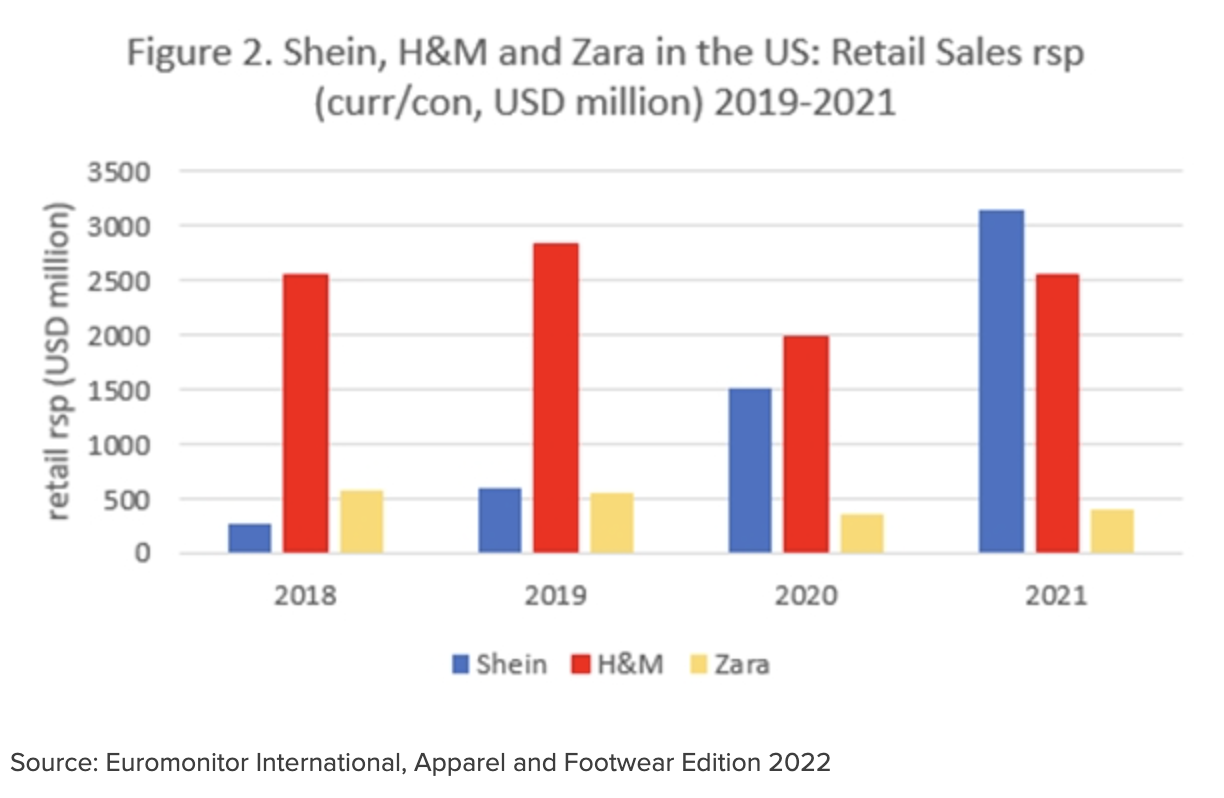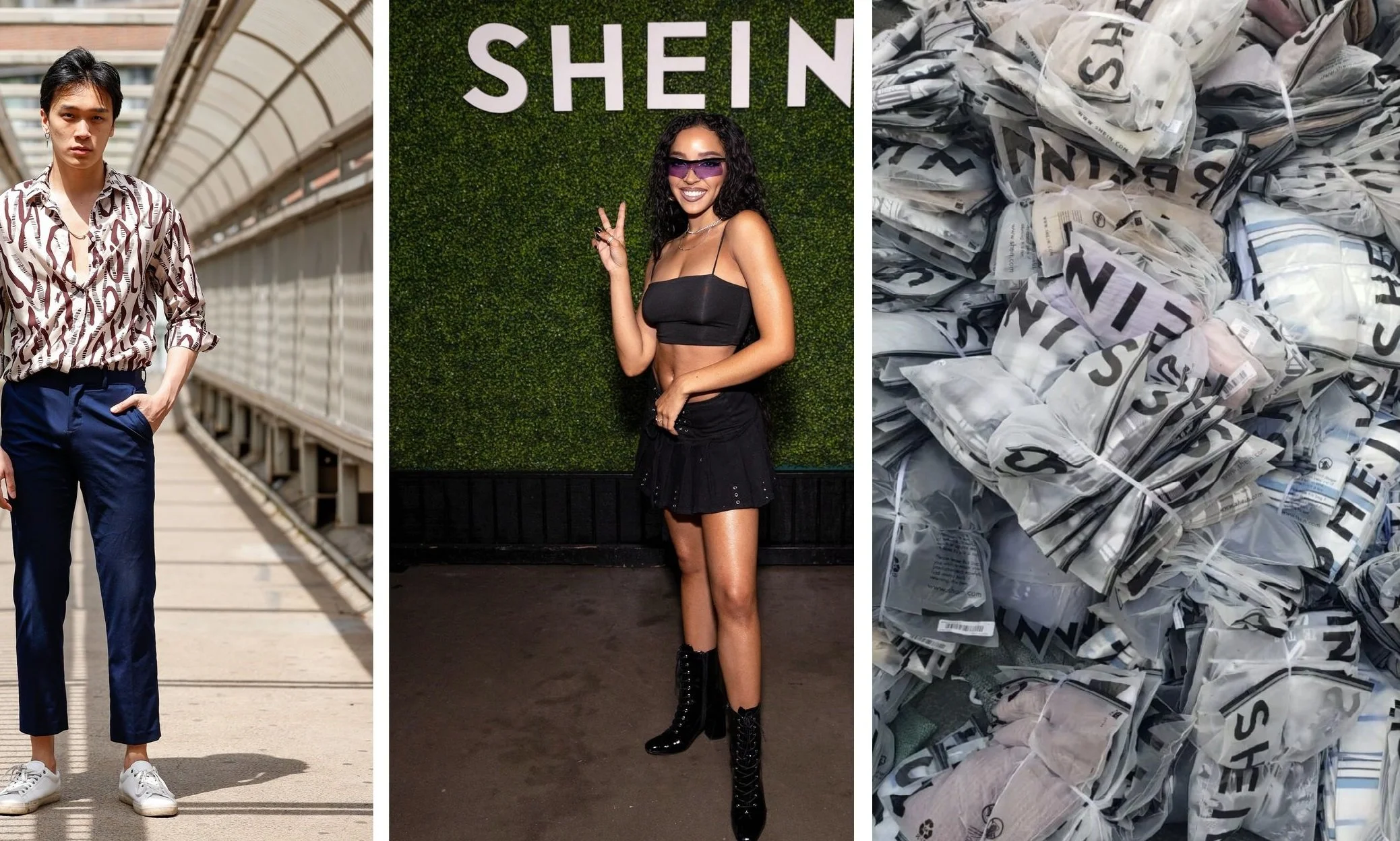Is SHEIN the Biggest Polluter In Fashion? Stats Are Damning but Do Americans Care?
/In August 2022, and with a September update, Anne of Carversville joined the growing chorus of environmentalists — young and old — screaming to the high heavens that Shein has become the biggest polluter in fashion, and its scale of environmental degradation is almost beyond our collective imaginations.
Certainly AOC did not understand the scale of Shein until viewing this graph comparing four years of revenue at Shein, H&M and Zara from 2018-2021.
Today, news is breaking that after last week’s March 2023 Congressional hearings about TikTok, a new coalition of environmentalists, activists and now online privacy protectors and national security professionals is creating a hypothetical “sister act” synergy between TikTok and Shein.
Called ‘ShutDownShein’, the new organization argues:
Shein and the insidious business model it is building on the backs of American children is a national security threat to the United States.
That’s a very dramatic assertion, and AOC hasn’t even read the entire press release. I can’t imagine America’s young women learning that there’s a serious movement to not only contain and regulate TikTok, but now to also take on Shein.
Clearly the new ShutDownShein movement went public this week because of the disastrous performance of TikTok CEO, Shou Zi Chew, a Singaporean businessman, before the House committee investigating China’s involvement in accessing TikTok user data.
If you are not informed about the scale of Shein and its very tight relationship with TikTok, read our original fall 2022 article while we digest today’s events, as narrated by the ‘Shut Down Shein’ press release.
Is SHEIN the Biggest Polluter In Fashion? Stats Are Damning but Do Americans Care?
[Updated September 19, 2022] Almost like a fashion space rocket, China-based Shein [pronounced she-in, not shine] now owns almost a third (28 per cent) of America’s fast fashion market.
Few sustainability warriors saw it coming. And for all the convos about young people being passionate eco-conscious caretakers of our planet, at least in America, they have given a big hug to Shein.
Since we wrote this article in August, the New York Times has returned with another in-depth look at Shein’s extreme popularity in America.
Honestly, the issue here is us, as American consumers. Anne of Carversville isn’t going to launch into an anti-business attack on Shein — although we are disgusted by all their cheap, cheap products.
The company wouldn’t make all their unsustainable, wear-once or twice cheap products without adoring American consumers — and especially young ones on TikTok — having fashion orgasms over how big their haul is for $100.
Unlimited Consumption and the American Dream
Many Shein customers are quoted in the new Times article saying they can’t afford H&M any longer. And AOC is among the many voices that have pressed on H&M to take seriously climate change and our need to decrease consumption. Buy fewer and buy better.
I’ve heard and read much about young consumers being more concerned about the environment, I no longer accept that ‘ism’ without more confirming data. Anecdotal data and polled results on environmental opinions among young people do not translate into just-say-no action when the topic is Shein. It’s just too cheap to resist.
AOC has long read Vox.com, and this article on American consumption rings true to me. In 2021, Emily Stewart spoke with Juliet Schor, a sociologist at Boston College, about the history of modern American consumerism — what it’s rooted in, how it’s evolved, and how different groups of people have experienced it.
Schor takes up the topic of competitive consumption, explaining the topic in America: “We have a society which is structured so that social esteem or value is connected to what we can consume. And so the inability to consume affects the kind of social value that we have. Money displayed in terms of consumer goods just becomes a measure of worth, and that’s really important to people.”
TikTok puts personal identity as defined by the clothes on our backs into the realm of competitive consumption on steroids. If fashion wasn’t the second worst polluter on the planet before Shein, we surely are now. Greenpeace noted in June 2022 that Shein had given a $15 million grant to an NGO working with waste workers in Ghana. Announced at the highly-regarded Copenhagen Fashion Summit, many sustainability experts layered charitywashing onto the topic of greenwashing. To be fair, here’s the Shein press release announcing the collaboration.
Fashion’s Rank as an Environmental Polluter
We have no agreement on where the fashion industry ranks among polluters on the planet. You will read the fashion occupies second place after oil, but in a dated but factual article written in December 2018, New York Times Fashion Editor Vanessa Friedman argues that very little data makes the case for fashion’s second-place ranking.
In a discussion that didn’t center on Shein in 2018, Friedman does accept data peppered all over AOC:
Consider the following:
Nearly three-fifths of all clothing ends up in incinerators or landfills within a year of being produced.
More than 8 percent of global greenhouse-gas emissions are produced by the apparel and footwear industries.
And, around 20 to 25 percent of globally produced chemical compounds are utilized in the textile-finishing industry.
Shein Facts that cause utter, total despair to those of us who see the planet on fire:
In 2021, the Shein app became the most downloaded with over 17.5 million downloads across the Google Play and Apple stores.
According to CEO Molly Miao, Shein releases between 700 and 1,000 new items a day, writes EuroNews. The items are tested in social media, with only the winners being produced in large quantities.
In a world where the average consumer throws away 60 percent of new clothes the year they are bought, Shein seeks to raise that number to 70-80 peercent.
AOC has strong feelings about the relentless attacks on H&M, who is sincerely trying to make forward progress on the sustainability front. These same activists never mention the name Shein, who is skyrocketing in the danger it levels on Planet Earth. The Shein facts are just astonishing. Admittedly, we are speechless.
H&M and Zara are the official boogeymen, because who can deal with factual complexity? Shein has zero commitments to sustainability that we know about, so it would be great for eco-warriors to turn their attention to Shein and China with as much activist enthusiasm as they expend on European brands like H&M and Zara.
One hears that Shein is trying to clean up its image in advance of an IPO. Here are media resources writing about the company.
Can Fast Fashion Ever Be Truly Sustainable? Surface Magazine
Shein is the future of fast fashion. Is that a good thing? VOX
Why can’t Gen Z — the world’s most eco-conscious generation — quit fast fashion? Fortune
Shein’s Rise Was Nearly Overnight. The Backlash Came Just As Fast Wall Street Journal
Why Clothes Are So Hard to Recycle BBC Future
BUT, where are the young journalists doing their own sustainability programming on TikTok? Anne of Carversville does not know the answer, but we are investigating what — if anything — exists as a counter-programming message.
Does TikTok organize sitdown video summits to discuss the environmental paradox created by fast fashion brands all the young people who love them to death. Our young people will have to live on this burning planet. Do they really make no connection between their fast-fashion Shein hauls and the impact on the environment? That is sad. Really sad. ~ Anne





















